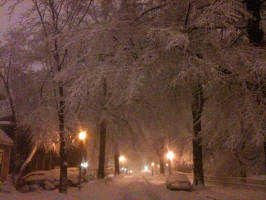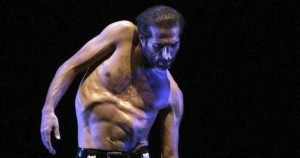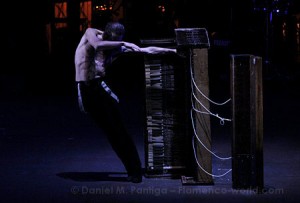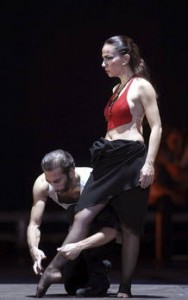By Brian Taylor Goldstein, Esq.
Hi Musical America,
I am a Danish citizen and I plan to go to the Unites States on a promo tour in spring. I know that it is necessary to apply for an O-1B visa being a solo artist. I have a native US promoter who will petition for me. My question is: How am I going to prove that I have “extraordinary ability” as a performer to qualify for an O-1B visa? It sounds to me that you need to be either Rolling Stones or Anna Netrebko to get through the needle’s eye. My music is folk/new age/healing and it has a limited audience. I do not have a big international following or a large music sale to boast. Any advice is appreciated.
While the US government doesn’t do much to support the arts, they threw us a tiny crumb when they wrote the O-1B regulations. As opposed to other professions covered by the O-1B category (sports, business, education, and science), an artist seeking O-1B classification does not have to be “extraordinary” to qualify for an “extraordinary ability” visa. Rather, the artist has to show that he or she is “distinguished.” The applicable regulations define “distinguished” as “…a degree of achievement and recognition beyond that ordinarily encountered.” While Mick Jagger and Anna Netrebko would most certainly qualify, you do not need to be at that level to obtain an O-1B visa. Nor do you need to compare your level of achievement and recognition to all musicians in all other genres. Rather, you only need to establish that you have “some” degree of recognition and achievement within the genre of folk/new age/healing music.
In preparing your petition, you would need to provide documentation of your career and achievements to show that you are at least “distinguished” in some way. Most often, these include copies of articles, reviews, blogs, and programs from your live performances, as well as any other materials written about you. You would also want to include copies of your recordings as well as proof of any awards you have won. You would want to explain that the genre of folk/new age/healing music does not get the same degree of press and attention as other genres, but that, within the genre of folk/new age/healing music, your are at least “highly praised” or “well-known”.
The most important thing is to explain everything to USCIS. The biggest mistake most artists and agents make is preparing a visa petition, attaching documents, and failing to write a comprehensive cover letter explaining the evidence. You want to hold the USCIS examiners hand and walk them through your qualifications step-by-step. Do not assume that the USCIS examiner listens to your genre of music (or ANY genre of music, for that matter) or is familiar with your awards. Explain every nuance. Explain your achievements. Explain every detail. Above all, make sure to provide translations of anything not in English.
Everything you could possible want to know about obtaining a visa for an artist is on the website www.artistsfromabroad.org. With some time and patience, you should be able to create a visa petition to obtain your O-1B without having won a Grammy, though I sincerely hope, one day, you do!
_________________________________________________________________
For additional information and resources on this and other legal and business issues for the performing arts, visit ggartslaw.com
legal and business issues for the performing arts, visit ggartslaw.com
To ask your own question, write to lawanddisorder@musicalamerica.org.
All questions on any topic related to legal and business issues will be welcome. However, please post only general questions or hypotheticals. GG Arts Law reserves the right to alter, edit or, amend questions to focus on specific issues or to avoid names, circumstances, or any information that could be used to identify or embarrass a specific individual or organization. All questions will be posted anonymously.
__________________________________________________________________
THE OFFICIAL DISCLAIMER:
THIS IS NOT LEGAL ADVICE!
The purpose of this blog is to provide general advice and guidance, not legal advice. Please consult with an attorney familiar with your specific circumstances, facts, challenges, medications, psychiatric disorders, past-lives, karmic debt, and anything else that may impact your situation before drawing any conclusions, deciding upon a course of action, sending a nasty email, filing a lawsuit, or doing anything rash!





Muti Taps the Liturgy
Tuesday, January 8th, 2013By ANDREW POWELL
Published: January 8, 2013
RAVENNA — Sacred music has lent gravitas to Riccardo Muti’s career since the 1960s. Settings of the Ordinary and the burial service by Bach, Mozart, Cherubini, Schubert, Berlioz, Brahms and Verdi have drawn his attention and received, more often than not, a disciplined performance.
No, this is not the repertory that leaps to mind when discussing the maestro from Molfetta. The operas of Verdi come first, and peer names like Arturo Toscanini, Herbert von Karajan and Claudio Abbado are soon raised. Muti the Verdian enjoys high standing — so high that he will be valued long after his own burial service for a trove of Verdi readings wider than Abbado’s, more eloquent than Karajan’s and better sung than Toscanini’s. (In context, it is worth hoping that his new biography of the composer will offer greater insight than his patchy 2010 autobiography.)
But music for the church points to the heart of this artist more directly than any opera. Where Abbado sees himself as a gardener, Muti’s alter ego is equipped as historian. Muti studies and diligently performs Mass settings — and antiphons, canticles, hymns and oratorios — out of a perceptive sense of their place in history, in a composer’s output, in the genesis of compositional technique and thought.
The effort is somewhat thankless. Sacred scores, particularly whole services, lack sway in a secular society and often lack musical balance too because of the characteristics of the liturgical sections. Many are front-loaded by a euphoric Gloria. Most end soberly, Haydn’s Paukenmesse being an exception to prove the rule. An established conductor who is not a choral conductor needs no Mass setting to boost his reputation, impress authenticists, sell tickets or oblige a record company. Yet Muti has forged ahead, Pimen-like, documenting scores others have not deigned to read. In one championing example, he has chronicled in sound no fewer than seven services by Cherubini.
In 2012–13 three sacred-music projects occupy him. Last August with the Vienna Philharmonic he persuasively reasserted his advocacy of Berlioz’s flamboyant, long-mislaid Messe solennelle, which he sees as a tribute to Cherubini, and this April in Chicago he revisits Bach’s B-Minor Mass.
Three weeks ago in Munich came Schubert’s A-Flat service, a non-commission from 1822 (D678). The songsmith struggled with its form. He did not follow early polyphonic precedent in imposing thematic unity; did not enjoy Bach’s or Haydn’s flair for satisfying church provisos while enhancing structure; did not write his own rules as would Berlioz and Verdi. Five handsome musico-liturgical sections were the result. A serene Kyrie and a radiant Agnus Dei, each with inventive, contrasting subsections. A protracted and prodigious, finally portentous, Gloria. A Credo that covers its narrative ground with storyteller fluency. A pastel-pretty Sanctus sequence. Call them Mass movements in search of containment.
Undeterred by the implicit challenge, Muti for his Dec. 20 concert with the Bavarian Radio Symphony Orchestra chose an 1826 revision that caps the Gloria with a bulky fugue, for Cum Sancto Spiritu. He made no attempt to harness Schubert’s ideas: sectional detachment and stylistic incongruities spoke for themselves, often elegantly.
Vocal and instrumental forces cooperated under tight reign, temporal more than dynamic. The BR Chor sang with customary refinement, applying Teutonic conventions in the Latin text. Ruth Ziesak and Michele Pertusi reprised the parts they took when Muti led this music in Milan’s Basilica di San Marco ten years ago. Still fresh of voice and keen to give notes their full value, the soprano found her form promptly after a grainy opening to the Christe eleison. Pertusi, in the modest bass part, blended neatly with his colleagues. Alisa Kolosova contributed an opulent alto, Saimir Pirgu an articulate, secure tenor; he participates in all three of the conductor’s Mass projects in 2012–13. On the Herkulessaal program’s first half, Mendelssohn’s Italian Symphony received a mundane traversal except in its agitated fourth movement, where taut rhythms left a lingering impression. The orchestra played attentively in both works.
Tepid applause followed the Mass, a contrast to the cheers that had erupted in Salzburg after the Berlioz work. Was this foreseen? Disappointing? In Italy they say Muti is addicted to applause. More likely is that audience reaction is beside the point for him: he simply wants clean execution, and he received it in Munich. Muti: “ … non siamo degli intrattenitori. La nostra professione è di un impegno maggiore … .” Pimen turns another page.
Toscanini and Karajan, those fellow Verdians, are not remembered for works destined to fall flat in concert. Both built careers on small sacred repertories: some half-dozen Mass settings each, beyond the not-quite-liturgical requiems of Brahms and Verdi. Beethoven’s hyper-developed and intimidating Missa solemnis had pride of place. Karajan revered the Bach as well (29 performances) and occasionally turned to Mozart’s Great C-Minor Mass and Requiem.
Abbado has, like Muti, taken up two Mass settings by Schubert: the tuneful early G-Major, which Muti performed in Milan twelve years ago, and the resourceful, variegated E-Flat Mass, the composer’s last. This work he paired with Mozart’s Waisenhausmesse (1768) in a jolly two-service concert in Salzburg six months ago. Both conductors have performed the two mature Mozart works and the Brahms and Verdi, but curiously neither man has tried a Mass setting by Haydn or Beethoven, casual research suggests.
To be sure, sacred music is not the mainstay of Muti’s career. His commitments to the Teatro dell’Opera di Roma, to the Chicago Symphony Orchestra and to Italy’s young-professional Orchestra Cherubini pull the emphasis elsewhere. But the passion for historical context that drives his Mass projects also shapes his priorities in symphonic repertory and opera. Instilled surely during formative years in Naples, it accounts for starkly independent programming choices and probably explains his famously firm way with the details of a score: the chronicler demands accuracy as well as loyalty to the composer. A tempo, però!
By happenstance this post is being drafted a few yards from the home of Muti and the tomb of Dante. They lie in opposite directions.
Photo © Soprintendenza per i Beni Architettonici e Paesaggistici
Related posts:
Spirit of Repušić
Muti Crowns Charles X
Muti the Publisher
Netrebko, Barcellona in Aida
Safety First at Bayreuth
Tags:Alisa Kolosova, Arturo Toscanini, Bavarian Radio Symphony Orchestra, BR Chor, Cherubini, Claudio Abbado, Commentary, Giuseppe Verdi, Herbert von Karajan, Michele Pertusi, München, Munich, Orchestra Cherubini, Ravenna, Recensione, Review, Riccardo Muti, Rome Opera, Ruth Ziesak, Saimir Pirgu, Schubert, Symphonie-Orchester des Bayerischen Rundfunks
Posted in Munich Times | Comments Closed